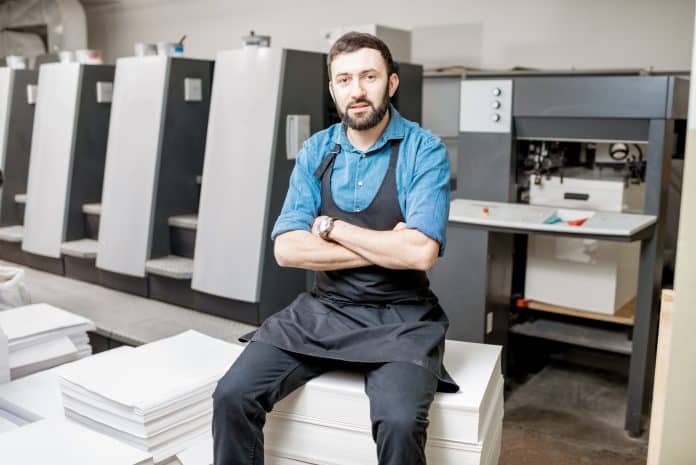Last updated on March 27th, 2024 at 02:04 pm
For prospective print customers, the difference between offset vs. digital printing is that digital printing is better suited for short run-printing (i.e. starting at 1 single copy) and offset printing is better suited for higher volume printing (i.e. starts being economical 2,000+ identical copies).
Both digital and offset printing produce print products that are extremely high in quality and fit for professional quality printing for businesses. The key factors that make customers choose digital printing vs. offset printing are typically the volume of the print project and niche project requirements.
There are other differences between digital printing vs. offset —such as color capabilities and sheet sizes that differ between offset print versus digital printing. Want to learn more about what is offset printing vs. digital printing? Find out what those differences are and as it pertains to buying print and compare digital vs. offset printing below!

The Different Printing Technology Used in Offset Printing Versus Digital Printing
The technological difference between difference between digital and offset printing is in the way the images get transferred onto the paper. It is this difference that affects the cost economics of running the digital printers machinery, and this difference in cost gets passed directly onto the printing customer.
Offset printing uses etched metal plates that apply ink onto a sheet of paper. The setup for offset printing is generally significantly more time consuming and expensive than digital printing. The metal plates—one plate per each color being used—need to be etched, and applied to the rollers that transfer the ink directly onto the paper. Then, the offset press needs to be run for a few minutes on “scrap” sheets of paper until the plates are properly inked; think of it like “warmup” sheets that are eventually thrown away.

On the other hand, digital printing uses electrostatic rollers—called “drums”—to apply toner and add full color onto the paper. The drums—again, one per each color being printed—use an electrostatic charge that attracts toner in the form of toner density. The toner is then applied onto the sheet and then fused—passed through a high-heat unit—onto the paper.

Digital printing can easily print out one sheet of paper or a copy of a Booklet Printing with minimal setup. However, offset printing requires a considerable amount more setup time and material. The ink and each sheet of paper that comes off of an offset press are actually cheaper than that of a digital press, but the savings only make sense if the print job is at a high enough volume.
Also—it’s the number of copies that counts; not the total number of sheets. Offset only makes sense if making a few thousand copies of the same sheets. So for example, if you’re printing 500 copies of a catalog that is 100 pages long, you’re printing 50,000 pages but only 500 copies. This would qualify as “short run printing”. (Offset doesn’t make sense because each sheet would require its own plate to be made.)
Most businesses today doing frequent, quick, and constantly changing print content opt for digital printing. On the other hand—businesses that print in volume and don’t change their content frequently opt for offset printing.
So again—the volume of printing is a key difference between difference between digital and offset printing.
Other differences between digital printing vs. offset printing
Even though the main factors when choosing a printing method are the printing needs and the minimum quantities of print runs, they’re not the only ones that determine the best solution. There are a few other differences between digital printing vs. offset printing that show up when print customers are shopping around for digitally printing services.
The first of those differences is the sheet size.
Digital printing typically runs smaller sheet sizes—typically 19” sheets with some machines going up to 29”. Offset printing on the other hand typically runs presses that are 29” and 40” sheets. This increase in size occasionally allows for some kinds of printing that isn’t possible on smaller sheets. Some examples include posters, book printing requiring large covers, and certain kinds of brochures.
When dimensional print size is important, but the print volumes don’t merit use of an offset press, customers frequently turn to digital wide-format presses for short-run printing. There are some cases of wide-format printing that cannot be done on digital wide-format presses—as in certain kinds of printing surfaces like packaging material, plastics, etc. This is when the preferred choice for the process might be offset printing, even for short-run production. When it comes to digital printing vs offset printing, weighing all of your options is important.
The second of those differences is the color representation.
Every piece of printing equipment offers slightly different interpretations and controls over how colors get applied onto a page. Offset presses can provide certain color controls that are superior to digital printing. For example, printing Pantone colors (a color management system) is more precise on offset presses because they actually use Pantone ink. This is important most typically for large corporate brands for which color consistency is worth a considerable amount of money.
The third of those differences is that digital presses are significantly cheaper for fast-turnaround projects.
Digital printing offers incredible turnaround times because of the significantly smaller setup time. Shops doing digital printing or digital printmaking well can offer same-day and next-day printing much more efficiently and cheaper than those with offset printing. For example, it would make sense to throw a project onto several digital presses that require minimal setup. On the other hand, throwing it onto multiple offset presses would require multiple plates and time to properly ink the plates. When turnaround time is a priority, digital print methods are a more cost-effective solution and better suited for tight deadlines.
To explore your printing options for offset and digital printing, please contact us today!







